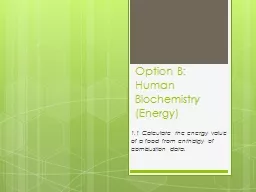

11 Calculate the energy value of a food from enthalpy of combustion data What is Biochemistry Biochemistry is the study of metabolic processes which includes a consideration of energy changes involved ID: 242770
Download Presentation The PPT/PDF document "Option B: Human Biochemistry (Energy)" is the property of its rightful owner. Permission is granted to download and print the materials on this web site for personal, non-commercial use only, and to display it on your personal computer provided you do not modify the materials and that you retain all copyright notices contained in the materials. By downloading content from our website, you accept the terms of this agreement.
Slide1
Option B: Human Biochemistry (Energy)
1.1 Calculate the energy value of a food from enthalpy of combustion data.
Slide2
What is Biochemistry?
Biochemistry is the study of metabolic processes, which includes a consideration of energy changes involved Slide3
Why is Energy So Important?
Our cells contain biological molecules involved in complex reactions
Metabolism – sum of all these reactions
Cells get energy through respiration (starts
with a simple sugar molecule
like glucose)
The body needs energy-rich molecules so metabolic processes can occur These molecules come from our diet, so it is important to know energy content of food (Joules) Slide4
Bomb Calorimeter
U
sed to measure the heat of combustion of a particular reaction
Food is placed in a container (bomb)
The bomb is placed in water
T
he food is ignited electrically and burned completely. Temperature increase of water is recordedThe specific heat capacity of water (amount of energy needed to raise the temperature of 1 gram of water by 1 Kelvin), temperature change in water, and mass of water are used to calculate the heat released by the food using the following equation:
q = mc Δ TSlide5
Diagram Slide6
q = mc
Δ
T
q = energy evolved (Joules)
m = mass of water (grams)
c = specific heat capacity of water (
4.18 Jg-1K-1)
ΔT = temperature change in water (Kelvin) Slide7
Example 1
A 0.78g sample of a food substance was combusted in a bomb calorimeter and raised the temperature of 105.10 g of water from 15.4°C to 30.6°C. Calculate the energy value of the food in kJ g
-1
.Slide8
Solution
Temperature rise in water = 30.6 – 15.4 = 15.2°C or 15.2
K
Specific heat capacity of water = 4.18 Jg
-1
K
-1 q = mc Δ Tq = (105.10 g) (4.18 Jg
-1K-1) (15.2 K) q = 6677.63 J per 0.78 g of sample heatedThe energy value =
= 8561.1 J g-1 or 8.56 kJ g-1 **If a question asks for an answer in J mol -1, multiply the answer in J g-1
by the molar mass ( g
mol
-1
)
Slide9
Example 2
1.50 g of glucose (C
6
H
12
O
6) was completely combusted in a bomb calorimeter. The heat evolved raised the temperature of 225.00 g of water from 18.50 °C to 27.96 °C. Calculate the energy value of glucose in kJ mol-1.Slide10
Solution
q
= mc
Δ
T
Temperature rise in water = 27.96 – 18.50 = 9.46°C or 9.46 KHeat evolved = (225.00 g) (4.18 Jg-1K-1) (9.46 K) = 8897.13 J
Mr (glucose) = 180 g mol-1energy value of glucose =
x 180 g mol-1 = 1,067,655.6 J mol-1 = 1070 kJ g mol-1 Slide11
Example 3
1.00 g of sucrose
,
C12
H
22
O11, was completely combusted in a food calorimeter. The heat evolved was equivalent to increasing the temperature of 631 g of water from 18.36°C to 24.58 °C. Calculate the calorific value of sucrose (in kJ mol-1) given the specific heat capacity of water in Table 2 of the Data Booklet.Slide12
Solution
M
r
for sucrose =342
H
eat
evolved = 0.631(kg)×4.18 (kJ kg-1K-1)×6.22(K) = 16.4 kJCalorific value = 5.61×103 kJ mol-1Slide13
References
Brown, C. , & Ford, M. . (2009).
Higher level chemistry developed specifically for the
ib
diploma
.Edinburgh
Gate, Harlow, Essex: Pearson Education Limited.Slide14
Any Questions?